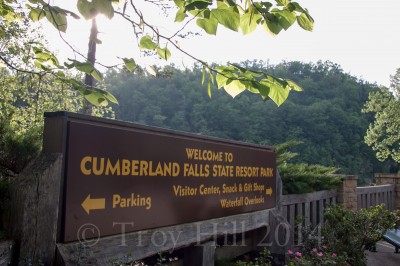 Don’t get mauled and eaten
Don’t get mauled and eaten
The first sign that we were leaving modern civilization wasn’t the serpentine path of rural highways 25W and 90 in southern Kentucky we had to dodge and weave as the locals flew past our slow progress, nor the plethora of country music we heard as we flipped radio stations along the drive. We, instead, realized that we were leaving behind modernity for the rustic life was the GPS app on our cell phone couldn’t decide if we were actually driving on I-75 or through a nearby mountain. Sadly, the cell reception wouldn’t improve with the proximity to our destination.
We were transplants from the “wilds” of the concrete jungles of suburban life from Indianapolis. We were heading into the wild backwoods of Kentucky, where bears and critters of all sizes roamed, where survival of the fittest ruled supreme. Or so we imagined, as we would our way down a modern highway that cut between swaths of forests and hills, dotted with signs of civilization such as Wal-Mart and Dairy Queen. Our goal was to find Cumberland Falls, located in a state park on the southern edge of central Kentucky. The falls were famous for being one of two waterfalls in the world with a Moonbow, or, rather, a rainbow visible under the light of the full moon. (more on this in part 2)
We left the highway at exit 25, a few miles north of the Kentucky-Tennessee border. Our small, red SUV would constantly be traveling at rates under the posted speed limit as we wound, climbed and dipped our way along the twists and hills of Kentucky’s highway 25W. Local drivers zoomed up to our back bumper. They backed off, once they saw the out of state plates on the vehicle. We were just another carload of slow Yankees from up north. They paced us from the rear was we slowed for the hairpin and dogleg curves they were used to flying through. Straight-a-ways were numerous, but short lived on these roads. The locals would eventually turn off into a side road. Freedom. Back up to the speed limit for them – caution for us.
Finally, after a curve and a short climb uphill, we saw a welcome sight. A dark brown wooden sign with lighter brown letters carved then painted into the wood, “Cumberland Falls State Resort Park.” But, another eight miles of twists, climbs, curves and dips in the road lay between us, and our destination.
Our little red SUV followed the serpentine path of asphalt through the Daniel Boone National Forest that stretches from the mountains of West Virginia, through Kentucky and down into Tennessee. We saw just a small slice of it. The National Forest surrounds the Kentucky state park at Cumberland Falls.
The area has a varied history of owners for the land, but the key point was when developers wanted to install a hydro-electric dam above the falls. Philanthropist T. Coleman DuPont offered in 1927 to purchase the land surrounding the falls in the Cumberland area and donate it to the state for a park. DuPont died before the Kentucky legislature voted to accept the offer in 1930. DuPont’s widow followed through on his offer, and purchased 593 acres surrounding the falls for almost half-a-million dollars, and donated it to the state. DuPont is the man the lodge building at the park is named for.
We didn’t see any bears as we drove the curves of Highway 90 toward the park. Suddenly, small raindrops began to hit our windshield, and quickly turned into a downpour, slowing us even more as we attempted to navigate the curling, climbing and diving road to the park. A few moments later, the rain let up as quickly as it hit.
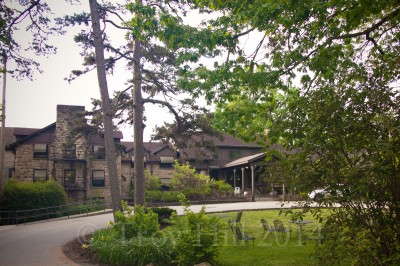 The DuPont Lodge sits atop a hill in the park, overlooking a portion of the Cumberland River that curls around the hill before one reaches the infamous falls portion. We pulled into the horseshoe drive, surrounding a lawn dominated by several stately oak trees, and dotted with wrought-iron tables and chairs. A couple of flat hammocks, which were stretched between modern timber frames, swayed slightly in the breeze. Rainwater had soaked their canvas and dripped slowly off the fabric. Condensation rose in wispy clouds from the warm asphalt, and rock around the lodge.
The DuPont Lodge sits atop a hill in the park, overlooking a portion of the Cumberland River that curls around the hill before one reaches the infamous falls portion. We pulled into the horseshoe drive, surrounding a lawn dominated by several stately oak trees, and dotted with wrought-iron tables and chairs. A couple of flat hammocks, which were stretched between modern timber frames, swayed slightly in the breeze. Rainwater had soaked their canvas and dripped slowly off the fabric. Condensation rose in wispy clouds from the warm asphalt, and rock around the lodge.
The original DuPont Lodge was built in 1935 by the Civilian Conservation Corps, a program under FDR’s New Deal, that employed men unable to find work during the Great Depression. The original structure featured 26 guest rooms and a dining hall, amidst the bear and critter infested woods, overlooking the scenic bends of the Cumberland River.
(More info on the park and DuPont Lodge at the official page here)
Unfortunately, their work went up in flames a few years later as the building caught fire and burned to the ground in 1938. Another New Deal program, the Works Progress Administration (WPA) brought the lodge back from the dead. WPA workers rebuilt it in 1940 as WWII loomed on the horizon for the workers and the rest of the world.
Once we arrived and parked along the horseshoe shaped drive in front of the lodge, we climbed the wide concrete steps to the hotel. Inside, we were greeted by a young man wearing a gray zippered sweatshirt with the park service logo on its left breast. As we asked for our reservation, the young man – Anthony, according to his engraved name tag – busied himself at his computer to find it. “How was the drive in?” he inquired in a southern drawl we northerners weren’t used to hearing yet.
“Not bad until the rain hit. The curves were fun up until then.”
He nodded. “We’ve had people arrive complaining of being motion sick when they first arrive.” He readied two plastic key cards. We were to be in the Woodland Rooms off of the main lodge. Handing us the key cards, he cautioned, “Don’t put these near anything magnetic like credit cards or cell phones. That will wipe them and they won’t work.”
He was correct. Twice I got my cell phone too close to the pocket where I stuck my card, and the card ceased working in the lock. One of those mishaps occurred during one of the rain squalls that pop up frequently in the area. Anthony refers the pattern in that section of the state as “Tri-polar Weather” – where the West to East flow from the plains meets the South to North flow from the Gulf, and both combine and bounce off the mountain range to the east, and double back on the area, making the weather attack them from three directions.
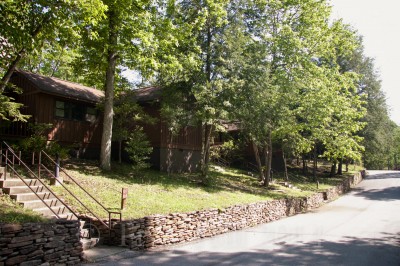 We headed back out into the muggy air and drove the short distance to Woodland Road where our “room” was located. The Woodland rooms are best described as a series of duplex cottages. Woodland road diverges off the lower left of the horseshoe drive. The cottages are situated on the side of the ravine that faces into the valley where the Cumberland River winds its way toward the famous falls. We were in one of the cottages on the odd numbered side, set above the narrow Woodland roadway. The even numbered cottages, set below the road, seemed to have a better view of the wooded ravine. Neither set, however, had a view of the river due to the dense woods that stretched between the small wooden buildings and the river half a mile away.
We headed back out into the muggy air and drove the short distance to Woodland Road where our “room” was located. The Woodland rooms are best described as a series of duplex cottages. Woodland road diverges off the lower left of the horseshoe drive. The cottages are situated on the side of the ravine that faces into the valley where the Cumberland River winds its way toward the famous falls. We were in one of the cottages on the odd numbered side, set above the narrow Woodland roadway. The even numbered cottages, set below the road, seemed to have a better view of the wooded ravine. Neither set, however, had a view of the river due to the dense woods that stretched between the small wooden buildings and the river half a mile away.
The woodland rooms are supposedly bigger than the lodge rooms and include a wet-bar area with cupboards, a dorm sized fridge, a four cup coffee pot, and a small microwave. Outside, the typical park style charcoal grill and wooden picnic table sit between the cottage buildings. Small wooden decks, big enough for a couple of chairs and a small side table jut out from each entryway.
For a few days stay, this was doable as our base of operations. Our MO for the week was a simple breakfast of yogurt and trail mix for my wife, yogurt and microwave ready bacon for me. She’d head out for about 7 to 10 miles of hiking and exploring, while I occupied a hammock or chair absorbing the view and working on readings for my graduate degree. I always warned her to be on the lookout for bears while she was out.
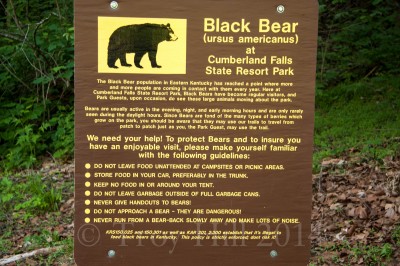 Scattered throughout the park, and even on the front doors of the lodge were warning signs that the black bear population is on the increase and sightings of bears in the park are normal. Visitors are warned that feeding bears or careless food disposal in areas open to bear visits are forbidden. I expected the signs to explain that violators of these precautions were likely to be mauled and eaten. Instead, a fine was the dire warning.
Scattered throughout the park, and even on the front doors of the lodge were warning signs that the black bear population is on the increase and sightings of bears in the park are normal. Visitors are warned that feeding bears or careless food disposal in areas open to bear visits are forbidden. I expected the signs to explain that violators of these precautions were likely to be mauled and eaten. Instead, a fine was the dire warning.
Still, mauling and being eaten would have carried more weight as a warning with me. That idea popped up in my mind each morning as I sat with coffee and my plate of microwave bacon on the deck of our Woodland room. Fortunately, the closest I came to getting mauled was when a stray black and white dog (far off the evolutionary chain from a black bear) wandered down the Woodland Road. He stopped and sniffed the air as the scent of bacon drifted out toward him. He then saw me move to get a better look at him. Off he scooted down the road, in search of easier bacon.
Sometime after noon, my wife, freshly showered after her morning hike, would meet me at the DuPont Lodge building for lunch. This, unfortunately, was an area with much promise but little delivery due to renovations to the building, which had just begun in a few weeks before our arrival.
Instead, we enjoyed dining in what was the original dining area – before the restaurant on the lower terrace was constructed in 1950. The room is a bit sterile with overhead fluorescent lighting, and tan walls, the room boasts a stone fireplace at one end, and a row of windows overlooking the monarch butterfly garden and horseshoe drive at the front of the lodge.
In the evenings, an adjoining meeting/dining room toward the back of the lodge was opened for dinner. The wall of panoramic windows provided a pleasant view of the wooded ravine but sits at the opposite end from the lower level restaurant, so the view of the river bend is limited. The gorgeous natural light flooding from the wall of windows was subdued by, again, overhead fluorescent lights that brought out the shine in the blond paneling on the end wall.
The restaurant staff was always pleasant and attentive. Unfortunately, with the kitchen for the dining room down a level – off the now closed restaurant – food had to be brought up by elevator. The staff definitely earned their tips with the extra mileage they endure to bring in the meals.
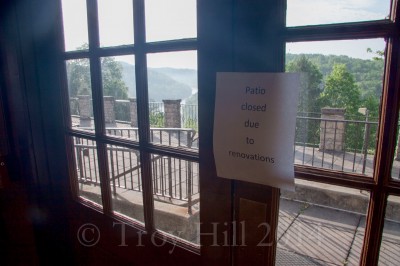 The renovations include the scenic patio. This is where I anticipated spending the majority of my study and communing with the natural scenery time. Unfortunately, that wasn’t to be – due to the impending renovations. Instead, I spent time reading in one of the hammocks or sitting at one of the tables on the lawn out in front of the lodge.
The renovations include the scenic patio. This is where I anticipated spending the majority of my study and communing with the natural scenery time. Unfortunately, that wasn’t to be – due to the impending renovations. Instead, I spent time reading in one of the hammocks or sitting at one of the tables on the lawn out in front of the lodge.
This might have been fortunate, considering the story that Connie, our server one evening told us. We asked if there had been much bear activity near the lodge. She smiled and said, oh, yes. Just a week or so ago, a couple of ladies were disappointed that the patio was closed, and asked to be let out on it for a few moments. Since no major construction on that part had begun, they were allowed to venture out.
While they stood and enjoyed the scenery, Connie said a young black bear that had been wandering the ravine by the river came up to the lodge and began climbing a tree to get on the patio’s upper level.
Upon seeing the tree shake, and the bear’s head and torso appear over the railing, one of the women walked over toward it, put her hands on her hips and commanded it “Git outta here.” She pointed at the ground below, explained Connie. “You git down from there.” And it did! Connie exclaimed.
Perhaps it’s for the best that “mauled and eaten” isn’t the penalty listed on the bear warning posters. I’d be more afraid if they sent that lady on the patio around with the ticket book to issue fines.
Historical Source: http://parks.ky.gov/parks/resortparks/cumberland-falls/history.aspx